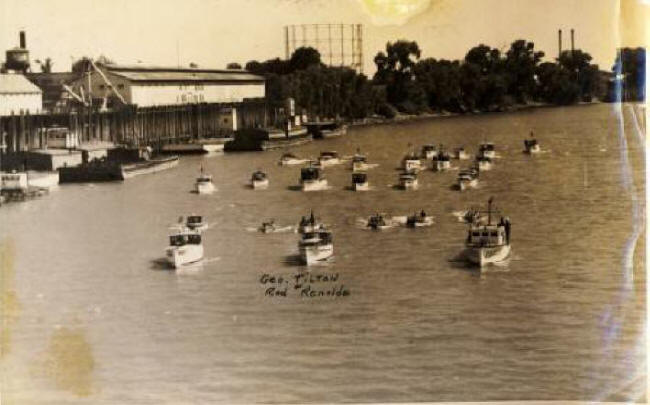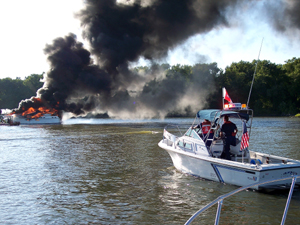District 11NR Public Information
| ►Prospective Members ►
New Members ►
Membership Process
►Opportunities ►Photo Gallery ►Boating Courses |
Programs Available in the Auxiliary District 11 North's public information page provides a wealth of resources:
| (I) Public Information Site Map | ||
%20Public%20Information%20Site%20Map.jpeg)
|
History of the Auxiliary
Visit the National Auxiliary Historical Site
The purpose of the Act, passed Oct. 19, is to assist the Coast Guard, as authorized by the Commandant, in performance of any Coast Guard function, duty, role, mission or operation authorized by law. This story hopefully will give you a broad knowledge of the Auxiliary, especially since reservists will be working with Auxiliarists even more in the future, as they become an increasingly important component in the Team Coast Guard line-up.
| When the Coast Guard "Reserve" was authorized by act of Congress on June 23, 1939, the Coast Guard was given a legislative mandate to use civilian volunteers to promote safety on and over the high seas and the nation's navigable waters. The Coast Guard Reserve was then a non-military service comprised of unpaid, volunteer U.S. citizens who owned motorboats or yachts |
Auxiliary Facilities, Tower Bridge Sacramento River - 1942
|
Two years later, on Feb. 19, Congress amended the 1939 act with passage of the Auxiliary and Reserve Act of 1941. Passage of this act designated the Reserve as a military branch of the active service, while the civilian volunteers, formerly referred to as the Coast Guard Reserve, became the Auxiliary. So, Feb. 19 is formally recognized as the birth of the Coast Guard Reserve while June 23 is recognized as birthday of the Coast Guard Auxiliary.
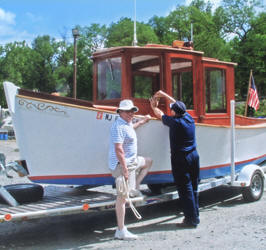 Vessel Examination |
When America entered World War II, 50,000 Auxiliary members joined the war effort. Some Auxiliarists served weeks at a time with the Temporary Reserve. They guarded waterfronts, carried out coastal picket patrols, rescued survivors from scuttled ships and did anything else they were asked to do. Many of their private vessels were placed in service. After the war, Auxiliarists resumed their recreational boating safety duties. The Auxiliary's four cornerstones - Vessel Examination, Education, Operations and Fellowship - were established and remain the Auxiliary's pillars today. |
The Vessel Examination program evolved into the well-known Courtesy Marine Examination (CME), a free examination available to any recreational boater. CMEs help boaters ensure their craft complies with Federal regulations.
| The Auxiliary operates safety and regatta patrols and is an integral part of the Coast Guard Search and Rescue team. Auxiliarists also stand communication watches, assist during mobilization exercises, perform harbor and pollution patrols, provide platforms for unarmed boarding parties and recruit new people for the Service. During Olympic yachting events in Savannah, Ga. last summer, the Coast Guard Auxiliary had 29 boats and a CG Auxiliary aircraft on hand for security operations. |
Boat on fire auxiliary boat standing by
|
Today, as in 1939, Auxiliarists are civilian volunteers who are authorized to wear a uniform similar to the Coast Guard Officer's uniform. Distinctive emblems, buttons, insignias, and ribbons are employed to identify the wearer as a member of the Auxiliary. One such insignia is the letter "A" on the shoulder boards of an Auxiliarist. Despite their silver shoulder boards (versus gold for Coast Guard officers), Auxiliarists hold no rank. The shoulder boards symbolize the office and level to which an individual Auxiliarist has been either appointed or elected.
The Auxiliary has members in all 50 states, Puerto Rico, the Virgin Islands, American Samoa, and Guam. Membership is open to men and women, 17 years or older, U.S. citizens of all states and territories, civilians or active duty or former members of any of the uniformed services and their Reserve components, including the Coast Guard. Facility (radio station, boat or aircraft) ownership is desirable but not mandatory.
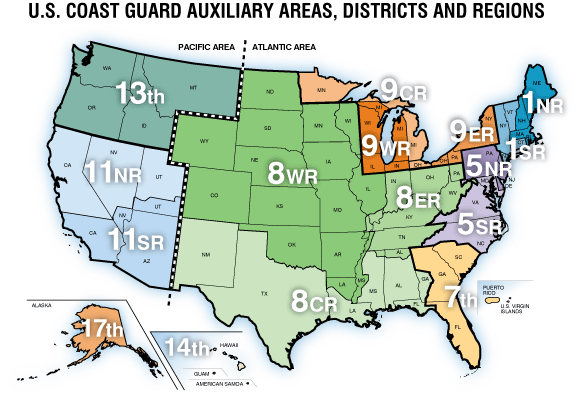
Although under the authority of the Commandant of the U.S. Coast Guard, the Auxiliary is internally autonomous, operating on four organizational levels: Flotilla, Division, District Regions and National.
Flotilla - The flotilla is the basic organizational unit of the Auxiliary and is comprised of at least 15 qualified members who carry out Auxiliary program activities. Every Auxiliarist is a member of a local flotilla. Each flotilla is headed by a Flotilla Commander (FC).
Division - For maximum administrative effectiveness in carrying out Auxiliary programs, flotillas in the same general geographic area are grouped into divisions. The division provides administrative, training and supervisory support to flotillas and promotes district policy. Each division is headed by a Division Captain (DCP), and Division Vice-Captain (VCP) and usually consists of five or more flotillas.
District/Region - Flotillas and divisions are organized in districts comparable to the Coast Guard Districts and must be assigned the same district number. Some districts are further divided into regions. The district/region provides administrative and supervisory support to divisions, promotes policies of both the district commander and national Auxiliary committee. All districts and regions are governed by a District Commodore (DCO), District Vice Commodore (VCO), and District Rear Commodore (RCO), under the guidance of the Coast Guard District Commander. At this level, Coast Guard officers are assigned to oversee and promote the Auxiliary programs.
National - The Auxiliary has national officers who are responsible, along with the Commandant, for the administration and policy-making for the entire Auxiliary. These officers comprise the National Executive Committee (NEXCOM) that is composed of the Chief Director of Auxiliary (an Active Duty officer), National Commodore and the National Vice Commodores.
NEXCOM and National Staff
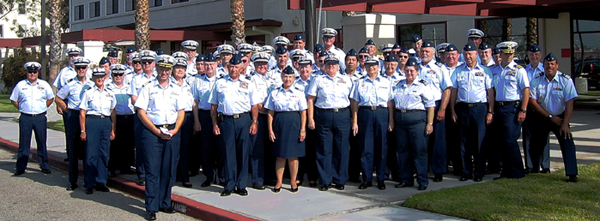
Auxiliarists are dedicated civilians who believe strongly in the Coast Guard and its missions. A hearty thank you is the only pay an Auxiliarist expects and receive tremendous satisfaction for a job well done.
Their efforts have proven valiant throughout the years as they take the oath of membership seriously. They contribute immeasurably to Team Coast Guard efforts.
Programs Available in the Auxiliary
Surface (water) Missions
- Safety Patrol - Patrol under Coast Guard orders using an Auxiliary Operational Facility.
- Regatta Patrol - Patrolling organized regattas and boat parades.
- Chart Update Patrol- Verifying the accuracy and completeness of information published on charts and related navigation publications.
- PWC Patrol - Patrolling on a Personal Water Craft (PWC).
- SAR Mission- Search And Rescue call out or the air equivalent to a vessel safety patrol.
- Enforcement of Laws and Treaties- Air support of a Coast Guard law enforcement mission.
- MEP Mission- Air support in the area of Marine Environmental Protection.
- Ice Operations Mission- Air support in the area of ice patrol operations.
- Logistics Mission- Transportation of personnel. Training Mission-
- Training missions involving air operations.
Land-based Operations Missions
- Radio Watchstander - Serving as a qualified watchstander at a Coast Guard or Auxiliary facility.
- Officer of the Day Duties- OOD at a Coast Guard facility either ashore or afloat.
- B-2 Alert SAR Standby- Time spent on stand-by.
- B-0 Alert SAR Standby- Standing by under with an Auxiliary Operational Facility for immediate call out.
- SAR Call Out- Search And Rescue call out involving communication facilities.
- CG Crew Augmentation- Serving as a qualified crew on Coast Guard, not Auxiliary, vessels.
- Enforcement of Laws and Treaties- Providing surface support of Coast Guard law enforcement mission.
- MEP Mission- Surface support for a Marine Environmental Protection mission.
- Auxiliary Radio Net Mission- Maintaining Coast Guard authorized Auxiliary radio nets.
- Aids to Navigation Mission-Federal - Servicing federal or private Aids to Navigation.
- Bridge Administration- Inspecting bridges.
Public Education Missions
- PE Other Than State/Youth - Auxiliary multi-lesson public education classes.
- State and Youth Courses- State public education classes and youth courses
- MT Instructor Mission- Member training activity, including specialty courses, boats crew training, and basic qualification classes.
Environmental Missions
- Enforcement of Laws and Treaties- Provide support to a Coast Guard law enforcement mission.
- Marine Environmental Protection- Provide support to the Coast Guard in the area of Marine Environmental Protection.
Coast Guard Support and Boating Safety Missions
- CG Operational Support- A service provided to operational Coast Guard units in support of Coast Guard programs.
- CG Administrative Support- Provide support to the Coast Guard in areas other than operations or recruiting.
- AIM Mission- The Auxiliary's Academy Introduction Mission (AIM).
- RAP Mission- Coast Guard Recruiting Assistance Program (RAP).
- Courtesy Marine Examinations- Vessel Safety Checks; Personal Water Craft Safety Checks; Uninspected Passenger Vessel; and Commercial Fishing Vessel.
- Public Affairs Mission- Promoting the Coast Guard, Coast Guard Auxiliary or Coast Guard Reserve.
- Program Visitor- Participating in the Program Safety Visitation Program.
Agency Support Missions
- Federal Agencies- Provide non-operational support to other federal agencies, such as Customs, Corps of Engineers and NOAA.
- State Agencies- Provide support to state agencies, such as the Department of Natural Resources, State Police and Marine Patrols.
- Local Agencies- Provide support to local agencies, such as local police, sheriff's offices, fire/rescue and Harbormasters.
Training Opportunities for Auxiliarist
Auxiliarist Courses
| Seamanship | Boat Crew | Navigation |
| Communication | Aids to Navigation | Search & Rescue |
| Patrols | Vessel Safety | Weather |
| Navigation Rules | Auxiliary Administration | Health & Safety |
| Marine Safety | Air Observer | Pollution Response |
Advanced Courses
The National "C" schools
Vision Statement consist of viewing training as a three tiered educational process and delivery system. These three levels are flotilla level training and certification, district/division training (including the annual National Training Conference), and the National "C" schools.
The national staff conducts national schools at CG training facilities in different parts of the country. Auxiliarists who have been active in their mission area, meet the course prerequisites, and agree to further train members in their own district/division upon return, are eligible to apply. All national schools have course prerequisites.
All Auxiliary national school are classified as CG "C" school training for purposes of messing, berthing, classroom, and logistics. Due to the limited number of quotas available to these schools, Auxiliarists are ineligible to attend if they have been enrolled in any Auxiliary national school within the past three years.
Coast Guard Courses
SAR School Training. National Search and Rescue schools may be offered annually to Auxiliarists in locations varying from year to year throughout the country. The general program consists of classroom lectures interspersed with practical problems, guest speakers prominent in the field of search and rescue, workshops, examinations, and homework. The SAR School training is advanced training designed to provide specific instruction to CG and selected Auxiliary personnel who may participate in SAR activities in CG Operations Centers (OPCENs).
Coast Guard Correspondence Courses
All correspondence courses offered by the CG Institute, except classified courses, are available to Auxiliary members. Aviation, boat-handling, damage control, electrical, electronics, telephone technician, navigation are a few that are offered
